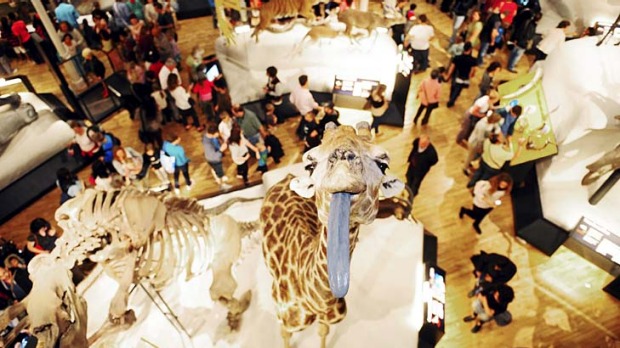
Jonathan Glancey tours the new National Museum of Scotland, filled with thousands of rediscovered objects.
A hippo suspended from the rafters. A Victorian lighthouse lens that once illuminated the Firth of Forth. A seal-gut anorak made by Inuits in the 1850s. An exotic bird stuffed by Charles Darwin.
Where did all this stuff come from? And why has so much of it - at least 8000 objects - only now gone on show for the first time since the old Royal Museum was formally opened in 1866?
Housed in a magnificent Victorian building, the former Edinburgh Museum of Science and Art forms one half of today's National Museum of Scotland. The other half, next door, dates from 1998 in a style that is half Scottish castle, half Le Corbusier monastery.
After a £47 million ($70 million) renovation, the 19th-century museum reopened last week and the two halves have finally been joined.
While the newer building is dedicated to showing objects made in Scotland, its restored Victorian sibling is a gloriously eclectic archive of the objects that Scottish explorers, inventors, soldiers and scientists brought back from their travels - as well as pieces from people such as Charles Darwin, who trained in Edinburgh.
Step inside, and you enter one of Scotland's finest new public spaces. A labyrinth of former storage spaces and dungeon-like workshops under the main museum floors has been opened. This low-lit vault will receive visitors, feed them in a fine new brasserie and then send them up from an atmosphere of romantic gloom into the galleries above.
Glass lifts and broad stairs lead up through apertures cut in the stones to a soaring, four-storey cast-iron and timber structure surrounded by intricate galleries.
"It's like a giant Victorian birdcage," says Dr Gordon Rintoul, the director of National Museums Scotland. "We've stripped it back to its Victorian glory," says the project architect, Gordon Gibb.
Here is a museum in which it is impossible to get lost. Wherever you walk, you will find yourself returning to the Grand Gallery. And, throughout, there is daylight: this is the least claustrophobic of museums.
When I ask Dr Rintoul if the museum is a bit of a rattle bag, he corrects me. "A rattle bag? The collection is very wide-ranging but it represents the sheer diversity of thought and activity that came out of the Scottish Enlightenment. Every object here tells a special story related to the ways in which Scotland went out to the world from the 18th century."
I do another turn around the galleries, looking at some of the thousands of objects rediscovered during the renovation. I'm lured first by the scaly-throated tree-creeper stuffed by Darwin during his expedition on board HMS Beagle, then by the Nobel prize medal awarded to the Scot Alexander Fleming for the discovery of penicillin. Above all, though, here is one of the truly great and beautifully remodelled Scottish buildings.
The National Museum of Scotland in Chambers Street, Edinburgh, is open daily 10am-5pm. Entry is free.
- Guardian News & Media